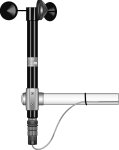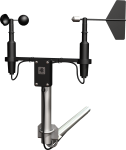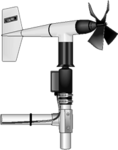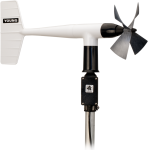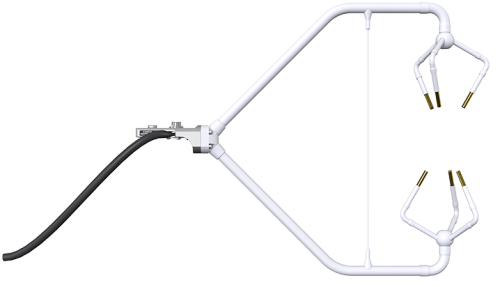
Best instrument for flux and other high-level turbulence research projects






Overview
The CSAT3A sonic anemometer head is similar to the sensor head from the CSAT3 sonic anemometer, but its cable is modified to connect to the EC100 electronics. It is used as part of the EC150 open-path analyzer and the CPEC200 closed-path eddy-covariance system.
Read MoreBenefits and Features
- New conformal coating helps protect sonic transducers in corrosive environments
- Innovative design provides precision turbulence measurements with minimal flow distortion
- Usually combined with EC150 or EC155 gas analyzers giving near complete colocation for eddy-covariance measurements
- Compatible with most Campbell Scientific data loggers
- Measurements can be used to calculate momentum flux and friction velocity
- Campbell Scientific’s fine wire thermocouples are an option for fast-response temperature measurements
- Field rugged
- Innovative signal processing and transducer wicks considerably improve performance of the anemometer during rain events
- Sealed sonic transducers and electronics
Images



Related Products
Technical Description
The CSAT3A is an optional component of an EC150 open-path or EC155 closed-path CO2/H2O gas analyzer. It attaches to a common mounting bracket and connects to the gas analyzer's EC100 electronics module.
Videos & Tutorials
Compatibility
Please note: The following shows notable compatibility information. It is not a comprehensive list of all compatible products.
Specifications
| Measurement Path Length |
|
| Path Angle from Horizontal | 60° |
| Construction | Sealed sonic transducers and electronics |
| Anemometer Head Materials | Stainless-steel tubing |
| Electronics Box Materials | Welded aluminum |
| Operating Temperature Range | -30° to +50°C |
| Voltage Supply | 10 to 16 Vdc |
| Current |
|
| Digital SDM Output Signal | CSI 33.3 k baud serial interface for datalogger/sensor communication. (Data type is 2-byte integer per output plus 2-byte diagnostic.) |
| Support Arm Diameter | 1.59 cm (0.63 in.) |
| Transducer Diameter | 0.64 cm (0.25 in.) |
| Transducer Mounting Arm Diameter | 0.84 cm (0.33 in.) |
| Anemometer Head Dimensions | 47.3 x 42.4 cm (18.6 x 16.7 in.) |
| Anemometer Head Weight | 1.7 kg (3.7 lb) |
Measurements |
|
| Outputs |
ux, uy, uz, c (ux, uy, uz are wind components referenced to the anemometer axes; c is speed of sound.) |
| Speed of Sound | Determined from three acoustic paths; corrected for crosswind effects. |
| Measurement Rate | Programmable from 1 to 60 Hz, instantaneous measurements. Two over-sampled modes are block averaged to either 20 Hz or 10 Hz. |
| Output Bandwidths | 5, 10, 12.5, or 20 Hz |
| Output Rate | 10, 20, 25, or 50 Hz |
| Measurement Resolution |
|
| Offset Error |
|
| Gain Error |
|
| Rain | Innovative ultrasonic signal processing and user-installable wicks considerably improve the performance of the anemometer under all rain events. |
Digital USB and RS-485 Output Signal |
|
| Baud Rate | 230400 bps (maximum) |
| Data Type | Comma-delimited ASCII |
SDM, USB, & RS-485 Digital Outputs Reporting Range |
|
| Full-Scale Wind | ±65.535 m/s autoranging between four ranges (Least significant bit is 0.25 to 2 mm/s.) |
| Speed of Sound | 300 to 366 m/s (-50° to +60°C) Least significant bit is 1 mm/s (0.002°C). |
Related Documents
Product Brochures
Manuals
- Open Path Eddy Covariance System with IRGASON or EC150/CSAT3A Quick Deploy Guide
- EC150 CO2 and H2O Open-Path Gas Analyzer and EC100 Electronics with Optional CSAT3A 3D Sonic Anemometer
- EC155 CO2 and H2O Closed-Path Gas Analyzer and EC100 Electronics with Optional CSAT3A 3D Sonic Anemometer
- CPEC300/306/310 Closed-Path Eddy-Covariance Systems
Related FAQs
Number of FAQs related to CSAT3A: 23
Expand AllCollapse All
-
No. The CSAT3 does not report time with the wind measurements. A time stamp will be assigned to the wind data by the data acquisition system—either a datalogger or a PC.
-
The CSAT3 offset specification is ±8 cm/s. Therefore, it cannot be used in an application where the expected wind speed is in the range of ±5 cm/s.
-
The CSAT3 measures three-dimensional wind in a right-handed Cartesian coordinate system. From these measurements, use trigonometry to compute the wind flow angle, horizontal angle, and wind speed.
-
Campbell Scientific does not offer any mounting booms or hardware that enable easy and frequent positioning of the CSAT3 sensor head. This type of hardware must be provided by the user.
-
The CSAT3 calibration applies a correction for transducer delay over temperature. Transducer delays cause an offset in the wind speed measurement, and to a lesser extent, an offset in the speed of sound measurement.
The CSAT3 speed of sound easement is corrected for the effects of wind blowing normal to the sonic path.
-
The CSAT3 is calibrated over temperature for the effects of transducer delays on the wind speed, and to a lesser extent, for the speed of sound measurements.
There is no NIST-traceable standard for ultrasonic anemometers.
-
The CSAT3 should not be used to measure absolute sonic temperature. Aside from the effects of water vapor in the sonic path, the speed of sound measurement is highly dependent on the ability of the CSAT3 to maintain its geometry. A 0.2 mm change in the sonic path is equal to a 1°C change in the measured absolute sonic temperature at 25°C. This is equal to a 0.33% error in the absolute sonic temperature. The wind speed measurements are also dependent on the sonic path distance, but to a lesser degree.
-
No. The CSAT3 is a sensor. Time stamps are assigned to the CSAT3 data by the data acquisition system—typically a Campbell Scientific datalogger or PC.
-
Ultrasonic anemometers are unable to make measurements if the sonic path is blocked. The path may become blocked by water that puddles on the lower transducer face or droplets that hang from the upper transducers.
-
The CSAT3 is calibrated over the temperature range of -30° to +50°C. The CSAT3 operating temperature range can be shifted by 10 degrees to cover the range of -40° to +40°C.
The instrument will continue to operate outside the calibrated temperature range; however, the proper calibration will not be applied to the measurements because it does not exist in the CSAT3 electronics.
Case Studies
Forest habitats contribute more than any other terrestrial biome to carbon cycles and processes. It......read more
Scientists and land-use managers have long recognized the importance of forest lands for their role......read more

